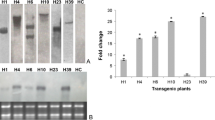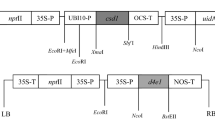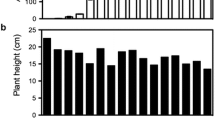Abstract
Citrus canker, caused by the bacterial pathogen Xanthomonas citri subsp. citri (Xcc), is a serious leaf and fruit spotting disease affecting many important citrus cultivars including grapefruit and certain sweet oranges. Currently, efficacious and economical disease control measures for highly susceptible citrus cultivars are lacking. Development of commercial cultivars with greater field resistance to citrus canker is the optimum strategy for effective disease management. In this study, we generated transgenic ‘Duncan’ grapefruit (DG) and ‘Hamlin’ sweet orange (Ham) expressing the Arabidopsis NPR1 gene (AtNPR1), which is a key positive regulator of the long-lasting broad-spectrum resistance known as systemic acquired resistance (SAR). Our results indicate that over-expression of AtNPR1 in citrus increases resistance to citrus canker and that the resistance is related with the expression levels of AtNPR1 in the transgenic plants. The line (DG 42-2) with the highest expression level of AtNPR1 was also the most resistant, which developed significant fewer lesions accompanied by a ten-fold reduction in Xcc population. The lesions developed on DG 42-2 were smaller and darker than those on the control and lacked callus formation. These lesion phenotypes resemble those on canker resistant kumquats and canker susceptible citrus trees treated with SAR-inducing compounds. Therefore, over-expression of AtNPR1 in citrus is a promising approach for development of more resistant cultivars to citrus canker.




Similar content being viewed by others
Abbreviations
- SA:
-
salicylic acid
- AtNPR1:
-
Arabidopsis nonexpressor of pathogenesis-related genes 1
- SAR:
-
systemic acquired resistance
- PR-2 :
-
pathogenesis-related protein 2
- INA:
-
2,6-dichloroisonicotinic acid
- BTH:
-
benzo(1,2,3)thiadiazole-7-carbothioic acid S-methyl ester
- ASM:
-
acibenzolar-S-methyl
- Imid:
-
imidacloprid
- Xcc :
-
Xanthomonas citri ssp. citri
- Psm :
-
Pseudomonas syringae pv. maculicola
- HR:
-
hypersensitive response
References
Alva, A. K., Graham, J. H., & Anderson, C. A. (1995). Soil pH and copper effects on young '‘Hamlin’' orange trees. Soil Science Society of America Journal, 59, 481–487.
Behlau, F., Belasque, J., Jr., Bergamin Filho, A., Graham, J. H., Leite, R. P., Jr., & Gottwald, T. R. (2008). Copper sprays and windbreaks for control of citrus canker on young orange trees in southern Brazil. Crop Protection, 27, 807–813.
Cao, H., Bowling, S. A., Gordon, S., & Dong, X. (1994). Characterization of an Arabidopsis mutant that is nonresponsive to inducers of systemic acquired resistance. Plant Cell, 6, 1583–1592.
Cao, H., Li, X., & Dong, X. (1998). Generation of broad-spectrum disease resistance by overexpression of an essential regulatory gene in systemic acquired resistance. Proceedings of the National Academy of Sciences of the United States of America, 95, 6531–6536.
Cheng, Y., Guo, W., Yi, H., Pang, X., & Deng, X. (2003). An efficient protocol for genomic DNA extraction from citrus species. Plant Molecular Biology Reporter, 21, 177a–177g.
Chern, M., Fitzgerald, H. A., Canlas, P. E., Navarre, D. A., & Ronald, P. C. (2005). Overexpression of a rice NPR1 homolog leads to constitutive activation of defense response and hypersensitivity to light. Molecular Plant-Microbe Interactions, 18, 511–520.
Dekkers, M. G. H., Graham, J. H., Burns, J. K., Cubero, J., & Colburn, G. C. (2004). Evaluation of chemical inducers and PR protein reporters for induced systemic resistance to citrus bacterial diseases. Phytopathology, 94, S25.
Durrant, W. E., & Dong, X. (2004). Systemic acquired resistance. Annual Review of Phytopathology, 42, 185–209.
Fitzgerald, H. A., Chern, M.-S., Navarre, R., & Ronald, P. C. (2004). Over-expression of (At)NPR1 in rice leads to a BTH- and environment-inducible lesion-mimic/cell death phenotype. Molecular Plant-Microbe Interactions, 17, 140–151.
Francis, M. I., & Graham, J. H. (2008). In vitro inoculation of citrus germplasm for rapid screening of resistance to citrus canker. Phytopathology, 98, S55.
Francis, M. I., Peña, A., Kostenyuk, I., Burns, J., & Graham, J. H. (2009a). HR-like resistance of kumquat (Fortunella spp.) to citrus canker caused by Xanthomonas citri sbsp. citri. Phytopathology, 99, S36.
Francis, M. I., Redondo, A., Burns, J. K., & Graham, J. H. (2009b). Soil application of imidacloprid and related SAR-inducing compounds produces effective and persistent control of citrus canker. European Journal of Plant Pathology, 124, 283–292.
Friedrich, L., Lawton, K., Dietrich, R., Willits, M., Cade, R., & Ryals, J. (2001). NIM1 overexpression in Arabidopsis potentiates plant disease resistance and results in enhanced effectiveness of fungicides. Molecular Plant-Microbe Interactions, 14, 1114–1124.
Gottwald, T. R., Graham, J. H., Civerolo, E. L., Barrett, H. C., & Hearn, C. J. (1993). Differential host range reaction of citrus and citrus relatives to citrus canker and citrus bacterial spot determined by leaf mesophyll susceptibility. Plant Disease, 77, 1004–1009.
Gottwald, T., Graham, J., Bock, C., Bonn, G., Civerolo, E., Irey, M., et al. (2009). The epidemiological significance of post-packinghouse survival of Xanthomonas citri ssp. citri for dissemination of Asiatic citrus canker via infected fruit. Crop Protection, 28, 508–524.
Graham, J. H., & Leite, R. P., Jr. (2004). Lack of control of citrus canker by induced systemic resistance compounds. Plant Disease, 88, 745–750.
Graham, J. H., & Myers, M. (2009). Soil drenches of imidacloprid, thiamethoxam and acibenzolar-S-methyl for induction of SAR to control citrus canker in young citrus trees. Phytopathology, 99, S46.
Graham, J. H., Gottwald, T. R., & Fardelmann, D. (1990). Cultivar-specific interactions for strains of Xanthomonas campestris from Florida that cause citrus canker and citrus bacterial spot. Plant Disease, 74, 753–756.
Graham, J. H., Gottwald, T. R., Cubero, J., & Achor, D. S. (2004). Xanthomonas axonopodis pv. citri: factors affecting successful eradication of citrus canker. Molecular Plant Pathology, 5, 1–15.
Leite, R. P., Jr., & Mohan, S. K. (1990). Integrated management of citrus canker disease caused by Xanthomonas campestris pv. citri in the State of Parana, Brazil. Crop Protection, 9, 3–7.
Lin, W. C., Lu, C. F., Wu, J. W., Cheng, M. L., Lin, Y. M., Yang, N. S., et al. (2004). Transgenic tomato plants expressing the Arabidopsis NPR1 gene display enhanced resistance to a spectrum of fungal and bacterial diseases. Transgenic Research, 13, 567–581.
Makandar, R., Essig, J. S., Schapaugh, M. A., Trick, H. N., & Shah, J. (2006). Genetically engineered resistance to Fusarium head blight in wheat by expression of Arabidopsis NPR1. Molecular Plant-Microbe Interactions, 19, 123–129.
Malnoy, M., Jin, Q., Borejsza-Wysocka, E. E., He, S. Y., & Aldwinckle, H. S. (2007). Overexpression of the apple MpNPR1 gene confers increased disease resistance in Malus x domestica. Molecular Plant-Microbe Interactions, 20, 1568–1580.
Mozoruk, J., Hunnicutt, L. E., Cave, R. D., Hunter, W. B., & Bausher, M. G. (2006). Profiling transcriptional changes in Citrus sinensis (L.) Osbeck challenged by herbivory from the xylem-feeding leafhopper Homalodisca coagulata (Say) by cDNA macroarray analysis. Plant Science, 170, 1068–1080.
Muraro, R. P., Roka, F. M., & Spreen, T. H. (2002). Grower costs of having citrus canker in Florida with an overview of Argentina’s citrus canker control program. Staff Paper SP02-3. Department of Food Resource Economics, Institute of Food and Agricultural Science, University of Florida
Orbović, V., & Grosser, J. W. (2006). Citrus: Sweet orange (Citrus sinesis L. Osbeck 'Valencia') and Carrizo citrange (Citrus sinesis (L.) Osbeck x Poncirus trifoliata (L.) Raf.). In K. Wang (Ed.), Agrobacterium protocol-methods in molecular biology (pp. 177–189). Totowa: Humana.
Potlakayala, S. D., DeLong, C., Sharpe, A., & Robert, P. R. (2007). Conservation of non-expressor of pathogenesis-related genes1 function between Arabidopsis thaliana and Brassica napus. Physiological and Molecular Plant Pathology, 71, 174–183.
Rinaldi, D. A. M. F., & Leite, R. P., Jr. (2000). Adaptation of Xanthomonas axonopodis pv. citri population to the presence of copper compounds in nature. Proceedings of the International Society of Citriculture, 2, 1064.
Schouten, H. J., Krens, F. A., & Jacobsen, E. (2006). Cisgenic plants are similar to traditionally bred plants. EMBO Reports, 7, 751–753.
Silverman, P., Seskar, M., Kanter, D., Schweizer, P., Métraux, J.-P., & Raskin, I. (1995). Salicylic acid in rice (biosynthesis, conjugation, and possible role). Plant Physiology, 108, 633–639.
Stall, R. E., Miller, J. W., Marco, G. M., & Canteros de Echenique, B. I. (1980). Population dynamics of Xanthomonas citri causing cancrosis of citrus in Argentina. Proceedings of the Florida State Horticultural Society, 93, 10–14.
Stall, R. E., Miller, J. W., Marco, G. M., & Canteros de Echenique, B. I. (1982). Timing of sprays to control cancrosis of grapefruit in Argentina. Proceedings of the International Society of Citriculture, 1, 141–417.
Verberne, M. C., Brouwer, N., Delbianco, F., Linthorst, H. J., Bol, J. F., & Verpoorte, R. (2002). Method for the extraction of the volatile compound salicylic acid from tobacco leaf material. Phytochemical Analysis, 13, 45–50.
Viloria, Z., Drouilard, D. L., Graham, J. H., & Grosser, J. W. (2004). Screening triploid hybrids of 'Lakeland' Limequat for resistance to citrus canker. Plant Disease, 88, 1056–1060.
Wildermuth, M. C., Dewdney, J., Wu, G., & Ausubel, F. M. (2001). Isochorismate synthase is required to synthesize salicylic acid for plant defence. Nature, 414, 562–565.
Acknowledgments
This work was supported by grants from Florida Citrus Production Research Advisory Council (FCPRAC) awarded to Z.M., W.D., and J.H.G. and a grant from the National Science Foundation (IOS-0842716) awarded to Z.M.. The authors are grateful to Dr. Xinnian Dong (Duke University) for the pKEx4tr-AtNPR1 cDNA plasmid and Dr. Sixue Chen (University of Florida) for access to the HPLC equipment. The authors thank Cecile Robertson and Alma Peña for technical assistance.
Author information
Authors and Affiliations
Corresponding author
Rights and permissions
About this article
Cite this article
Zhang, X., Francis, M.I., Dawson, W.O. et al. Over-expression of the Arabidopsis NPR1 gene in citrus increases resistance to citrus canker. Eur J Plant Pathol 128, 91–100 (2010). https://doi.org/10.1007/s10658-010-9633-x
Received:
Accepted:
Published:
Issue Date:
DOI: https://doi.org/10.1007/s10658-010-9633-x




